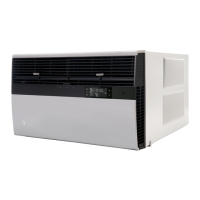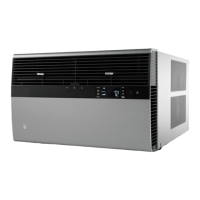36 PB
OPERATION
Refrigeration Sequence Of Operation
Agoodunderstandingofthebasicoperationoftherefrigerationsystemisessentialfortheservicetechnician.Withoutthis
understanding,accuratetroubleshootingofrefrigerationsystemproblemswillbemoredifcultandtimeconsuming,ifnot(in
somecases)entirelyimpossible.Therefrigerationsystemusesfourbasicprinciples(laws)initsoperationtheyareasfollows:
1. “Heatalwaysowsfromawarmerbodytoacoolerbody.”
2. “Heatmustbeaddedtoorremovedfromasubstancebeforeachangeinstatecanoccur”
3. “Flowisalwaysfromahigherpressureareatoalowerpressurearea.”
4. “Thetemperatureatwhichaliquidorgaschangesstateisdependentuponthepressure.”
Therefrigerationcyclebeginsatthecompressor.Startingthecompressorcreatesalowpressureinthesuctionlinewhich
drawsrefrigerantgas(vapor)intothecompressor.Thecompressorthen“compresses”thisrefrigerantvapor,raisingits
pressureandits(heatintensity)temperature.
TherefrigerantleavesthecompressorthroughthedischargeLineasahotHighpressuregas(vapor).Therefrigerantenters
thecondensercoilwhereitgivesupsomeofitsheat.Thecondenserfanmovingairacrossthecoil’snnedsurfacefacilitates
thetransferofheatfromtherefrigeranttotherelativelycooleroutdoorair.
Whenasufcientquantityofheathasbeenremovedfromtherefrigerantgas(vapor),therefrigerantwill“condense”(i.e.
changetoaliquid).Oncetherefrigeranthasbeencondensed(changed)toaliquiditiscooledevenfurtherbytheairthat
continuestoowacrossthecondensercoil.
Thedesigndeterminesatexactlywhatpoint(inthecondenser)thechangeofstate(i.e.gastoaliquid)takesplace.Inallcases,
however,therefrigerantmustbetotallycondensed(changed)toaLiquidbeforeleavingthecondensercoil.
TherefrigerantleavesthecondenserCoilthroughtheliquidlineasawarmhighpressureliquid.Itnextwillpassthroughthe
refrigerantdrier(ifequipped).Itisthefunctionofthedriertotrapanymoisturepresentinthesystem,contaminants,andlarge
particulatematter.
Theliquidrefrigerantnextentersthemeteringdevice.Themeteringdeviceisacapillarytube.Thepurposeofthemetering
deviceisto“meter”(i.e.controlormeasure)thequantityofrefrigerantenteringtheevaporatorcoil.
Inthecaseofthecapillarytubethisisaccomplished(bydesign)throughsize(andlength)ofdevice,andthepressuredifference
presentacrossthedevice.
Sincetheevaporatorcoilisunderalowerpressure(duetothesuctioncreatedbythecompressor)thantheliquidline,the
liquidrefrigerantleavesthemeteringdeviceenteringtheevaporatorcoil.Asitenterstheevaporatorcoil,thelargerareaand
lowerpressureallowstherefrigeranttoexpandandloweritstemperature(heatintensity).Thisexpansionisoftenreferred
toas“boilingoratomizing”.Sincetheunit’sblowerismovingindoorairacrossthennedsurfaceoftheevaporatorcoil,the
expandingrefrigerantabsorbssomeofthatheat.Thisresultsinaloweringoftheindoorairtemperature,or“cooling”.
Theexpansionandabsorbingofheatcausetheliquidrefrigeranttoevaporate(i.e.changetoagas).Oncetherefrigeranthas
beenevaporated(changedtoagas),itisheatedevenfurtherbytheairthatcontinuestoowacrosstheevaporatorcoil.
Theparticularsystemdesigndeterminesatexactlywhatpoint(inthe
evaporator)thechangeofstate(i.e.liquidtoagas)takesplace.Inall
cases,however,therefrigerantmustbetotallyevaporated(changed)
toagasbeforeleavingtheevaporatorcoil.
Thelowpressure(suction)createdbythecompressorcausesthe
refrigeranttoleavetheevaporatorthroughthesuctionlineasacool
lowpressurevapor.Therefrigerantthenreturnstothecompressor,
wherethecycleisrepeated.
Suction
Line
Evaporator
Coil
Metering
Device
Refrigerant
Strainer
Discharge
Line
Condenser
Coil
Compressor
Refrigerant Drier
Liquid
Line
Figure 345 (Refrigeration Sequence Of Operation)

